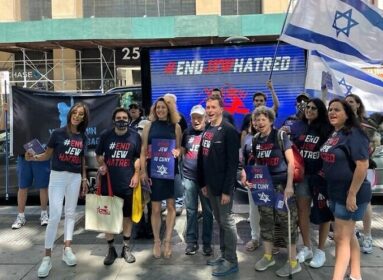West Hartford high school addresses anti-Semitic incidents
By Cindy Mindell
 WEST HARTFORD – The administration of Hall High School in West Hartford is reacting to two incidents with anti-Semitic overtones. Both incidents of what the school is calling “intolerance” occurred on school grounds earlier this month.
WEST HARTFORD – The administration of Hall High School in West Hartford is reacting to two incidents with anti-Semitic overtones. Both incidents of what the school is calling “intolerance” occurred on school grounds earlier this month.
First, during a soccer game between Hall and West Hartford’s Conard High School, hosted by Hall on Thursday, Oct. 2, fans of both teams reportedly exchanged offensive chants. Then, on Monday, Oct. 6, an English classroom wall was defaced with a swastika, drawn in green marker.
Almost a week after the initial incident, in an email sent on Wednesday, Oct. 8 to students, faculty, and parents of both high schools, Principals Dan Zittoun of Hall and Julio Duarte of Conard described the two incidents and outlined their schools’ planned respective plans of action.
The email read, “Derogatory taunts and symbols of hatred, racism, and anti-Semitism have no place in our vision for our students and our community, and there is absolutely no place for these behaviors and actions in our schools and at events. All students have the right to feel safe, respected, and connected in their schools, and a proper, supportive environment is essential for learning.”
Zittoun says that he attended the soccer game but didn’t hear the offensive language, learning about it afterward from parents whose children had been at the game. He contacted Duarte, and the principals reported both incidents to Superintendent Thomas Moore on Tuesday afternoon.
Bruce Putterman, chair of the West Hartford Board of Education, heard about both incidents from Hall parents on Tuesday, two hours before that evening’s regular Board of Education meeting. Reports indicated that Conard students had sung Hava Nagila and The Dreidel Song at Hall students, who reportedly responded with their own taunt. Many Hall students reported that coaches for both teams remained silent. The Ledger was able to confirm the Conard taunt, but was unable to confirm the response by Hall students.
At the BOE meeting, Putterman addressed both incidents in a statement: “I am raising this issue to condemn it and to start a dialogue between students, teachers, and parents about how hurtful this kind of behavior is, even if it doesn’t seem that way to the perpetrators.” Superintendent Moore responded by pledging to take action so that students feel safe in the West Hartford schools. At the meeting, Zittoun and Duarte drafted their letter.
“We saw that we wanted to get the whole community aware of what had happened, because it does take a village,” Zittoun says. “If students are not hearing the same message at home and in school, they’re getting a mixed message about what is appropriate behavior. We must show a basic level of respect for all people. Whether it’s an antisemitic or racist incident, or one targeting gender or sexual preference, there is absolutely no place for these behaviors and actions in our schools and at events.”
The joint email was sent out on Wednesday morning.
Meanwhile, the Jewish community had already been discussing the incidents via social media, alerted by Hall students reporting to their parents.
One Jewish student in the English classroom where the swastika had been drawn could see the offensive graffiti showing through a sheet of paper taped onto the wall. She took a photo of it with her cellphone and showed it to her mother. The girl related that, when a fellow student asked the teacher what was under the paper, the teacher announced to the class that there was a “hateful symbol” on the wall and that the janitor had been asked to remove it.
“My daughter wasn’t upset, but just wanted me to see what somebody had done,” says the mother, who requested anonymity. She emailed Zittoun, “not because I wanted this kid to be punished for doing something stupid, but I hear about the environment my child is going to school in and I don’t like to see any kind of intolerance,” she says.
Zittoun called the mother to assure her that the administration would follow up on the incident. “He was very receptive,” she says. “My point, which I discussed with him, is that I don’t care specifically that it was a swastika; I care that my daughter goes to a school where there is a community of mutual respect. I would hope she would come home and tell about any incident, racist or anti-sexual orientation, not only an antisemitic one. To get the community to come together, it needs to be an issue that everyone can feel.”
Another parent, who also asked to remain anonymous, told the Ledger that she found the principal less responsive. When she called Zittoun and asked whether the incidents would be addressed in a school statement or at that evening’s Board of Education meeting, the principal answered no.
Zittoun explained to the Ledger that, when the mother contacted him, he and Duarte were still collecting information about the two incidents and did not yet feel that a statement was warranted until they understood the scope of the offensive behavior.
Zittoun says that he was not in a position to raise the incidents at the Board of Education meeting, as town protocol dictates that the superintendent of schools consults with the BOE chair, who then sets the meeting agenda. Zittoun and Duarte reported the incidents to Moore and Morrow before the meeting, and board chair Bruce Putterman discussed the issue with Moore, informing him that he would be making a statement at the meeting.
Zittoun also received a call from Gary Jones, Connecticut regional director of the Anti-Defamation League, who had learned about the swastika late Monday from at least one parent. Jones encouraged the principal to issue a statement reflecting the school’s position on racist behavior.
“The key is that the school needs to make clear where it stands and that symbols of hate are totally inconsistent with the values of the school system and the town,” Jones says. “I’m happy that both school administrations did so; I think that’s very important.”
Jones also discussed how ADL has guided other school administrations facing similar situations.
From its extensive experience in providing anti-bias and anti-bullying education, ADL recommends a three-step response, he says. First, if possible, identify the offender and assess appropriate disciplinary action. Next, issue an explicit response to the school community. Third, initiate an educational component associated with the response.
“Kids should understand the significance of a symbol like a swastika so that they are sensitized about future incidents,” he says. “Hopefully, they will understand that they’re also helping the school system in standing up for people who are victimized by these things to make sure that they don’t happen – but if they do, they can stand up for those targeted so that the school system knows about it and does the right thing.”
ADL, which facilitates anti-bias and anti-bullying educational programs in schools across the state, has not brought the training to Hall in several years, Jones says.
“There is no right or wrong way to provide this kind of education,” he says. “But it’s important to do something to show that the school is not only saying no, but doing so for a very important and appropriate reason.”
While he is not aware of an official Board of Education protocol for addressing displays of intolerance, Zittoun says that the swastika should have been dealt with more quickly. The English teacher did report the graffiti to school administration when she discovered it, but only in the form of a work order to have it removed. The swastika and paper covering were still on the wall on Tuesday, but removed by the time students arrived on Wednesday morning.
“We explained to the teacher that she should call the office right away and we’ll come in, document it, and get it off immediately,” Zittoun says, though he and Jones note that graffiti is usually left up long enough to aid in an internal and/or police investigation.
“We’re looking to improve upon our process,” Zittoun says. “You take every incident as a learning tool. We want to talk with staff to make sure they understand the protocol and how to respond and, for me as a principal, to make sure that it’s not there the next day.”
While the internal investigation proceeds, Zittoun is discussing educational programming together with Hall faculty and student- activity and advisory groups.
“It’s our goal to change the culture at Hall and that needs to come from within,” he says. “I don’t want to do one quick thing – like a school assembly – so that the adults feel good but doesn’t have a lasting impact. To have somebody come in, do the presentation, and leave, I’m not sure that would have the same impact as something that came from the student body and the community that has a vested interest in seeing that change over time.”
Jones agrees that a school or other community must be committed to change over time.
“We’re a long way from living in an environment where no one will do these things,” he says. “The key to making people feel safe and secure is to know that any time anyone of a particular religion or race becomes the victim of a hate incident, they have a supportive environment around them. With the right support, we can make a community whose members know what they’re supposed to do and that makes it much easier, more comfortable, and secure for the victim. Turning bystanders into allies makes all the difference.”
Some believe that, while ADL’s tactics are well-meaning, they may not be as effective as hoped.
Dr. Yifrah Kaminer is an adolescent psychiatrist at UConn who specializes in high-risk behavior, and a member of the Hall High School PTO. “Teaching world religions should not be a superficial review with a positive spin on the ‘American Way;’ that is, style over content and facts to make everyone happy,” he says. “Learning and discussing historical facts that address the roots of the conflicts between Christianity and Judaism that led to organized anti-Semitism and its devastating consequences should be a priority. A similar creative approach to address racism and the like would be challenging yet productive.”
Kaminer suggests incorporating texts like Constantine’s Sword by James Carroll and From Jesus to Christianity by L. Michael White.
In response to derogatory language at sports events, Kaminer believes that students from both sides should be banned from at least one game, the same protocol followed by FIFA, the international governing body of association soccer.
“I am not pro-punishment for the students who used these hateful expressions, if caught,” he says. “However, their parents should be informed and the students should have to conduct research on the sources of antisemitism, present their findings to their class, and be graded. Shame is a greater punishment than any disciplinary one.”
The Jewish community bears a lot of responsibility for setting a suitable tone, Kaminer says. “Last but not least, I’d like to hear a courageous response from Jewish community leaders.”
Comments? email cindym@jewishledger.com.









 Southern New England Jewish Ledger
Southern New England Jewish Ledger











